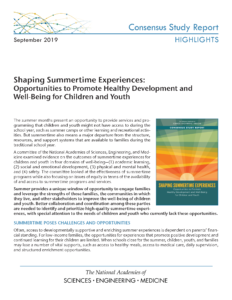

The summer months present an opportunity to provide services and programming that children and youth might not have access to during the school year, such as summer camps or other learning and recreational activities. But summertime also means a major departure from the structure, resources, and support systems that are available to families during the traditional school year.
A committee of the National Academies of Sciences, Engineering, and Medicine examined evidence on the outcomes of summertime experiences for children and youth in four domains of well-being—(1) academic learning, (2) social and emotional development, (3) physical and mental health, and (4) safety. The committee looked at the effectiveness of summertime programs while also focusing on issues of equity in terms of the availability of and access to summertime programs and services.
For More Information . . . This Consensus Study Report Highlights was prepared by the Board on Children, Youth, and Families based on the Consensus Study Report, Shaping Summertime Experiences: Opportunities to Promote Healthy Development and Well-Being for Children and Youth (2019). The study was sponsored by the Robert Wood Johnson Foundation and The Wallace Foundation. Any opinions, findings, conclusions, or recommendations expressed in this publication do not necessarily reflect the views of any organization or agency that provided support for the project. Copies of the Consensus Study Report are available from the National Academies Press, (800) 624-6242; http://www.nas.edu/Summertimeopportunities.
see allThere is an unprecedented sense of urgency, calls to action, and investment of resources from... read more
Introduction Across grade levels, afterschool programs are helping young people find their passions, express themselves,... read more
Helping teachers improve their instructional practice through high-quality professional learning opportunities is a key strategy... read more
The National Summer Learning Project (NSLP), an initiative of The Wallace Foundation, consists of five... read more